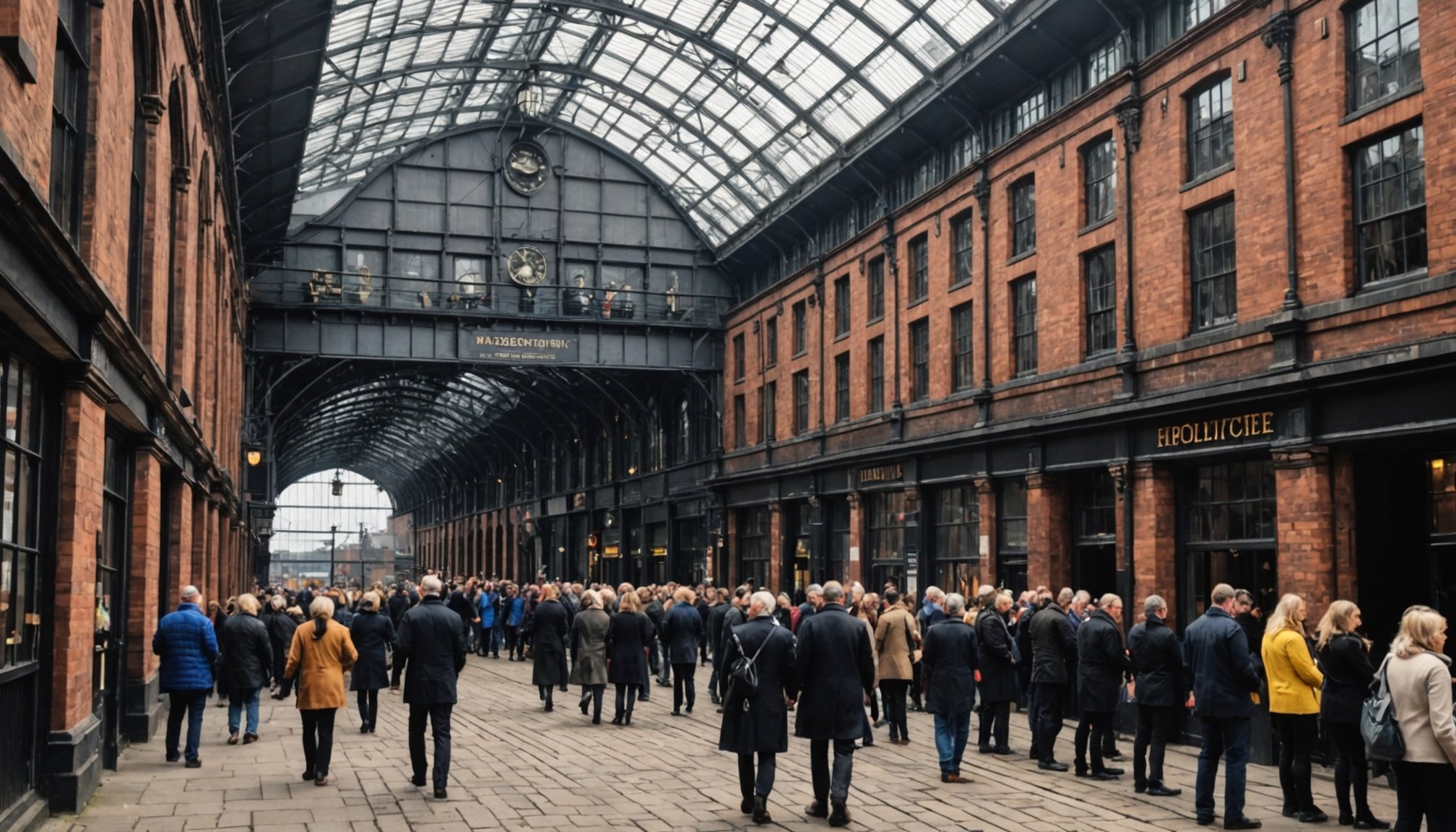Unveiling Manchester: Must-See Sites to Experience the Rich Heritage of the Industrial Revolution
Manchester, a city in the north of England, is a treasure trove of history, particularly when it comes to the Industrial Revolution. This city, once a small market town, transformed into a global industrial powerhouse, leaving behind a rich legacy that is still palpable today. Here’s a guide to the must-see sites that will help you delve into Manchester’s fascinating history.
Exploring the Heart of Manchester’s Industrial Past
The Science and Industry Museum
To truly understand Manchester’s role in the Industrial Revolution, a visit to the Science and Industry Museum is essential. Located on the site of the world’s first passenger railway station, this museum is a testament to Manchester’s pivotal role in industrial innovation. The museum offers interactive exhibits that showcase the city’s industrial past, from steam engines to textile machinery, making it an engaging destination for visitors of all ages.
In the same genre : Ultimate guide to an unforgettable experience at the national museum of scotland: insider tips you can’t miss!
- Historic Machinery Demonstrations: Don’t miss the museum’s demonstrations of historic machinery in action. Watching these industrial giants come to life gives you a real sense of the ingenuity and hard work that drove Manchester’s development.
- Interactive Exhibits: The museum features a range of interactive exhibits that allow you to explore the science and technology behind Manchester’s industrial achievements.
- Temporary Exhibitions: The museum also hosts regular events and exhibitions that delve into various aspects of science and innovation, keeping the experience fresh and relevant[1][4][5].
Castlefield Urban Heritage Park
Castlefield is a unique blend of industrial history and modern urban development. This area, once home to Roman forts and industrial canals, has been transformed into a tranquil urban oasis. Walking through Castlefield, you’ll find picturesque bridges, moored narrow boats, and plenty of green spaces to relax in.
- Preserved Canals and Warehouses: The preserved canals, cobbled streets, and old warehouses stand in stark contrast to the sleek modern buildings that now surround them.
- Evening Atmosphere: Visit the area in the evening when the canal-side bars and restaurants come alive, making it a perfect spot for a romantic dinner or a relaxing drink by the water[1][3].
Discovering Manchester’s Architectural Gems
John Rylands Library
The John Rylands Library is more than just a place for book lovers; it’s a breathtaking example of neo-Gothic architecture. Opened in 1900, this library houses some of the most significant rare books and manuscripts in the world, including a Gutenberg Bible and the personal papers of Elizabeth Gaskell.
Have you seen this : Unleash fun: the ultimate guide to devon”s best dog-friendly beaches for unforgettable adventures!
- Guided Tours: Take a guided tour to learn about the history of the library and its collections. The knowledgeable guides provide fascinating insights into the building’s past and the treasures it holds.
- Architectural Marvel: The library’s architecture alone is worth the visit, with its soaring ceilings, intricate carvings, and stunning stained glass windows[1].
Manchester Town Hall
Manchester Town Hall, completed in 1877, is a masterpiece of Gothic architecture and a symbol of the city’s civic pride. This building, often described as a “municipal palace,” features ornate Gothic stonework, statues of the city’s founding fathers, and a main tower that rises like a church spire.
- Gothic Architecture: Unlike Liverpool, which favored classical style, Manchester chose Gothic architecture for its Town Hall, reflecting the city’s unique identity.
- Historical Significance: The building is adorned with six-petaled cotton flowers and bee motifs, symbolizing the raw material and hard work that made Manchester rich[4].
Uncovering Hidden Gems and Street Art
Ancoats and the Old Mill
Ancoats, once a thriving industrial district, is now one of Manchester’s trendiest neighborhoods. Here, you can explore the oldest surviving cotton mill in Manchester, the Old Mill, completed in 1798. This area is also home to incredible hidden street art.
- Street Art Hunt: Keep an eye out for murals and installations that reflect the area’s industrial heritage and creative spirit. The ‘Worker Bee’ mural is a must-see, symbolizing Manchester’s industrious past[1][2].
- Artisanal Food Scene: Combine your street art hunt with a visit to one of Ancoats’ popular coffee shops or bakeries, known for their artisanal food scene[1].
Delving into Social and Political History
The People’s History Museum
The People’s History Museum is the UK’s national center for the collection, conservation, and study of material relating to the history of working people. Located in a former Edwardian pump house, the museum tells the story of democracy and social change in Britain through engaging exhibits and interactive displays.
- Collection Highlights: The museum’s collection includes banners, posters, and artifacts that highlight the struggles and triumphs of the working class.
- Temporary Exhibitions: Check out the museum’s temporary exhibitions, which often focus on contemporary issues related to democracy and social justice, providing a modern context to the historical displays[1].
Navigating Manchester’s Waterways and Industrial Estates
Manchester Ship Canal and Salford Quays
The Manchester Ship Canal, completed in 1894, was a monumental engineering project that linked Manchester directly to the sea. Today, the Salford Quays area has been redeveloped into a modern hub with attractions like The Lowry and the Imperial War Museum.
- The Lowry: This cultural center houses the finest collection of L.S. Lowry’s paintings, along with a theater, shop, and restaurant.
- Imperial War Museum: Designed by Daniel Libeskind, this museum focuses on the experience of living through conflict with 360-degree audiovisual presentations[4].
Practical Insights and Tips for Your Visit
Walking Tours and Hidden Gems
Manchester is a city best explored on foot. Here are some tips for your walking tour:
- Start in the City Centre: Begin your journey in the heart of Manchester, where you can visit the Manchester Cathedral and the nearby Victoria Baths.
- Explore the Northern Quarter: This vibrant area is home to street art, independent shops, and a thriving food scene.
- Visit Local Markets: Check out the local markets, such as the Manchester Craft and Design Centre, where you can find unique handmade items and enjoy the Victorian architecture[1][4].
Free Attractions and Budget Tips
Manchester offers a range of free attractions that make it an accessible destination for all:
- John Rylands Library: Admission is free, making it a must-visit for anyone interested in history and architecture.
- People’s History Museum: This museum is also free to visit, providing a wealth of information on social and political history.
- Castlefield Urban Heritage Park: This park is free to explore and offers a peaceful escape from the city’s hustle and bustle[1].
A Detailed Guide to Must-See Sites
Here is a detailed list of must-see sites to help you plan your trip to Manchester:
-
Science and Industry Museum
-
Location: Liverpool Road, Manchester
-
Highlights: Interactive exhibits, historic machinery demonstrations, temporary exhibitions
-
Tips: Plan a full day visit to explore all the exhibits thoroughly[1].
-
John Rylands Library
-
Location: 150 Deansgate, Manchester
-
Highlights: Neo-Gothic architecture, rare books and manuscripts, guided tours
-
Tips: Take a guided tour to get the most out of your visit[1].
-
Castlefield Urban Heritage Park
-
Location: Castlefield, Manchester
-
Highlights: Preserved canals, old warehouses, green spaces
-
Tips: Visit in the evening for a romantic dinner or a relaxing drink by the water[1].
-
Ancoats and the Old Mill
-
Location: Ancoats, Manchester
-
Highlights: Street art, Old Mill, artisanal food scene
-
Tips: Combine your street art hunt with a visit to a local coffee shop or bakery[1][2].
-
People’s History Museum
-
Location: Left Bank, Spinningfields, Manchester
-
Highlights: Collection of working-class history, temporary exhibitions
-
Tips: Check out the temporary exhibitions for a modern context to the historical displays[1].
-
Manchester Ship Canal and Salford Quays
-
Location: Salford Quays, Manchester
-
Highlights: The Lowry, Imperial War Museum, modern architecture
-
Tips: Plan a day trip to explore the Salford Quays area thoroughly[4].
Table: Comparing Key Attractions in Manchester
| Attraction | Location | Highlights | Tips |
|---|---|---|---|
| Science and Industry Museum | Liverpool Road | Interactive exhibits, historic machinery demonstrations, temporary exhibitions | Plan a full day visit to explore all the exhibits thoroughly |
| John Rylands Library | 150 Deansgate | Neo-Gothic architecture, rare books and manuscripts, guided tours | Take a guided tour to get the most out of your visit |
| Castlefield Urban Heritage Park | Castlefield | Preserved canals, old warehouses, green spaces | Visit in the evening for a romantic dinner or a relaxing drink by the water |
| Ancoats and the Old Mill | Ancoats | Street art, Old Mill, artisanal food scene | Combine your street art hunt with a visit to a local coffee shop or bakery |
| People’s History Museum | Left Bank, Spinningfields | Collection of working-class history, temporary exhibitions | Check out the temporary exhibitions for a modern context to the historical displays |
| Manchester Ship Canal and Salford Quays | Salford Quays | The Lowry, Imperial War Museum, modern architecture | Plan a day trip to explore the Salford Quays area thoroughly |
Quotes and Anecdotes
- “Manchester remained a small market town until the late 18th century and the beginning of the Industrial Revolution. The Spinning Jenny in 1764 marked the beginning of the Industrial Revolution and brought with it the first fully mechanised production process.”[5]
- “The town’s growth was given further impetus in 1620 with the start of fustian weaving. In this period Manchester grew heavily due to an influx of Flemish settlers who founded Manchester’s new weaving industry.”[3]
- “The human energies that once made Manchester into ‘Cottonopolis’ are still palpable today, in the old mills and giant warehouses, municipal buildings and art galleries, museums and town squares.”[4]
Manchester is a city that wears its heart on its sleeve, proudly displaying its rich history and industrial heritage. From the grand architecture of the John Rylands Library to the vibrant street art of Ancoats, and from the interactive exhibits of the Science and Industry Museum to the tranquil oasis of Castlefield, there is something for everyone in this dynamic city. Whether you are a history buff, an art enthusiast, or simply someone looking to explore a new city, Manchester is a destination that promises to leave you with lasting memories and a deeper appreciation for the Industrial Revolution.
So, pack your bags, grab your camera, and get ready to unveil the wonders of Manchester. As you walk through its streets, you’ll find that the city’s history is not just a relic of the past but a living, breathing part of its present and future.











